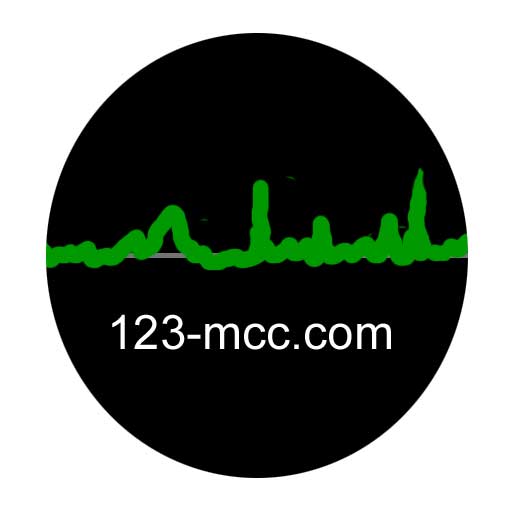
Angus and Rosemary's Miscellany
of Malvern - Other Resources
|
History menu > Electrical engineering companies then and nowSummaryA long time ago, when we were young, we were told that the world was a rapidly changing place so be prepared to adapt. The truth of this is reflected by the fact that very few of the companies we considered when we were first looking for work now exist. Here is our account of what happened to some of them. Of course we cannot cover them all, so this page is about the history of some, mostly British, radio, TV, and large electrical engineering companies. There is also mention of later avionics, telecomms and software consultancy businesses which evolved from them. Only a brief mention of each company is given as there are links you can click to find out more. Many web pages have been created by ex employees wanting to record the history of their long gone company for posterity. 
ContentsPhoto opposite: variable air spaced tuning capacitor in home-made crystal set. Radio industryThe British Broadcasting Company was formed in 1922 which became the British Broadcasting Corporation in 1927. Crystal sets, which were listened to with headphones, were very popular in the early days of radio as they were cheap to buy and did not require batteries. Some early radios used a lead acid accumulator to supply the valve heaters. Older Malvern residents remember, as children, taking the heavy accumulator to a shop or garage to be charged. In the 1930s mains sets became more popular as prices fell and the creation of the National Grid resulted in a standardised mains supply. 'Superhet' receivers were introduced which translated the received frequency to a lower fixed Intermediate Frequency (IF) where filters gave better selectivity. Following the outbreak of WWII in 1939 many manufacturers came under government control and were diverted to production for the war effort, while large numbers of radio and TV engineers were called upon to work at government research establishments such as TRE and ADRDE in Malvern where radar was developed, and RAE Farnborough. When the war was over, government contracts ended, and staff no longer needed by the research establishments had to find new jobs. After the war, for example, a member of the family moved from RAE Farnborough to Allander Industries, Bridgton, Glasgow. Allander manufactured Radios and Radiograms and exhibited at a trade fair at Olympia in 1947, but in 1948 the company went bust. Radios in those days were expensive and small companies were not able to compete with the larger manufacturers. In the 1950s the family had a large old, mains operated, radio which had been made in the 1930s. It used large valves about the size of a 60W filament light bulb. The dial glowed an amber yellow colour and contained the names of stations such as Paris and Hilversum that bore no relation to the stations that could be received. During the day these were the BBC Home Service and Light Programme. This radio emitted a reassuring hum and warm air from the back. There was also a 'modern' PYE mains radio with a plug in aerial wire that ran up the side of the house. That had smaller 20 mm diameter valves and a short wave position where you could receive crackles and hisses from around the world and occasionally a programme in a foreign language, particularly at night, when ionospheric conditions were more favourable. About 1960 we had a radiogram that played 45 rpm and 33 rpm LP gramophone records. The latter lasted about 15 minutes per side. The radiogram had a valve operated FM/VHF radio and the sound quality was very good. VHF broadcasting operates at about 100 MHz and uses Frequency Modulation (FM) modulation. Wideband FM can provide a better signal to noise ratio than AM which can be valuable for listening to classical music but at the expense of a wider bandwidth necessitating a channel spacing of about 200 KHz.
The Medium Waveband extended from about 530 to 1600 KHz with the Home Service then also being broadcast on 200 KHz Long Wave (Radio 4 is now on 198 KHz). The LW transmission from Droitwich could be received in most areas of the UK, unlike MW signals which did not propagate so well. On LW and MW amplitude modulation was used with 9 KHz channel spacing In 1961, following the invention of the transistor, Bush brought out the smaller TR104 transistor radio operating from a single 9V PP9 battery which was much cheaper to run; the radio then cost about £14 equivalent to £350 at 2012 prices. The radio used a compact ferrite rod aerial incorporated within the set (see example in photo below migrated to a crystal set).
The ferrite rod is a man made ceramic material containing iron oxide onto which is wound the tuning coil. It adequately functions as a magnetic core at medium wave frequencies, but becomes lossy at higher frequencies such as at VHF where use of a telescopic aerial is common for portable sets. (FM and DAB micro systems often have a coaxial socket to which can be connected either an external dipole aerial, a tape folded dipole, or a short length of wire which often works just as well). Ecko, named after its founder E K Cole was another make of radio. Ecko merged with PYE and ceased trading in the 1960s. The TR104 was built on a metal chassis and soldered by hand, but soon radios were being assembled on a printed circuit board and soldered by machine.
The development of the compact audio cassette tape by Philips led to the popularity of mains/battery radio cassette players in the 1980s and micro stereo systems. Circa 2010 these were no longer made and largely replaced by DAB radio/CD players. The development of the digital frequency synthesizer, the Radio Data System (RDS) and liquid crystal displays led to more sophisticated analogue radios with digital tuners which were simpler to tune and with an alarm clock function. RDS enabled the radio to switch to a better frequency, to traffic announcements, display station name, and set the clock. RDS is gradually being superceded by DAB. See example of a Sony ICF-M50DS radio, made in Malaysia, below. 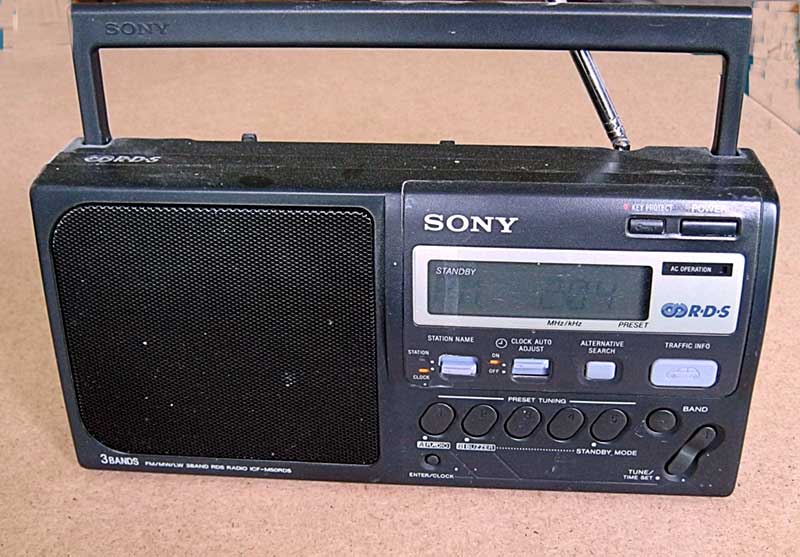
About 2005 Digital Audio Broadcasting (DAB) was introduced. The main advantage for us is that you can receive old comedy programmes on Radio 4 Extra (previously named Radio 7), but significant disadvantages can be that fading causes the audio to drop out for several seconds at a time and, for portable use, the power consumption is currently much higher than for a MW radio so the batteries do not last long. DAB operates at about 200 MHz and uses less spectrum than FM so more channels can be accommodated. DAB radio programmes can also be received on Freeview by digital TVs in which case programmes can be recorded on either DVD or Hard Disk recorders or downloaded from the Internet using, for example, BBC Iplayer. Television industryEarly experiments with TV in the 1930s were stopped by WWII. Television started coming into the home in the 1950s providing a black and white picture and 405 lines resolution. Initially there was only one channel, and broadcasting hours were limited. Test cards were transmitted during the day so that TV engineers could adjust the sets. 1950s TVs used the small EF80 valve made by Mullard, which replaced the much larger EF50 used during the 1940s, designed by Philips. In the 1960s, 625 line resolution was introduced and colour sets began to appear about 1967. TV sets were manufactured in the UK by PYE, Ferguson, GEC, Thorn, Ultra Electronics and others but sales declined in the 1970s as more reliable colour sets were imported from Japan. Some TVs were made at the Ultra factory in Gosport from 1958 to about 1990. Later, Japanese companies outsourced production to eg eastern European countries; nowadays the brand name no longer gives a clear indication of country of manufacture. In the 1970s the BBC introduced CEEFAX (also known as Teletext) which enabled textual information carried on a sideband to be displayed such as the weather forecast and share prices. In 2012 the UK switched off the last analogue TV transmissions, moving to digitally coded HD television offering 1098 lines resolution. This marked the end of CEEFAX which has been replaced by the similar but faster TEXT function on digital TVs. Long ago, following the introduction of semiconductors, factories stopped producing valves for TVs. Since about 2005 the production of CRT displays has rapidly declined following the introduction of LCD and Plasma colour flat screen displays for TVs and PCs. It seems that after 1970 British companies were slower to innovate in global markets and had difficulty competing in terms of product features, price, and reliability. Other companiesIn the 1960s British car manufacturers began to suffer competition from more reliable Japanese imports and the textile industry suffered competition from Asia. Engineering companies likewise met with fierce competition both at home and abroad. Few of the electrical engineering, avionics and software companies that were in existence when we started work still exist apart from IBM and HP. Many companies were taken over and some went bust. Associated Electrical IndustriesAEI was a heavy electrical engineering holding company. In 1967 it merged with GEC. Admiral Computing GroupAdmiral was a software consultancy company founded by engineers who had left EASAMS. It was first registered about 1982. It grew steadily from small beginnings becoming a Public Limited Company circa 1987. In 2000 the company was taken over by CMG. BAE Systems plcBAE Systems is a relatively new British multi-national defence and aerospace company formed by the nationalisation of the British aircraft industry in 1977 followed by privatisation by the Thatcher government in the 1980s. Since then it has made various acquisitions including the Marconi Electronic Systems division of GEC in 1999. It is now Britain's largest defence contractor. CMGCMG was a British software consultancy company. Soon after acquiring Admiral Computing it merged with Logica. In 2012 Logica was taken over by CGI of Canada. A C CossorA C Cossor was a British Electronics company that was acquired by the US Raytheon Group about 1961. During WWII Cossor manufactured equipment for the Chain Home Radars. Decca
Decca also made the Decca Navigation System that was developed in WWII. The system was rendered obsolete by SATNAV and was switched off in 2000. EADSThe European Aeronautic Defence and Space company (EADS) is a major new foreign consortia formed by the merger of French and German aerospace companies in 2000. Electronic Data SystemsEDS was an American information technology company. It acquired the British SD-Scicon and was itself taken over by Hewlett Packard in 2008. ElliottElliott Automation was a British electronics and computer company. The computer part of the company was merged with International Computers and Tabulators in 1967 to form International Computers Ltd; the remainder of the company was merged with English Electric. Elliott's manufactured the popular medium size Elliott 803 computer in the 1960s. Elliott Automation Space and Advanced Missile Systems division (EASAMS) became a division of GEC offering project management and consultancy services. English ElectricEnglish Electric was a large British industrial manufacturer. Besides making locomotives, electric motors and generators it made the Canberra jet bomber and Lightning jet fighter. English Electric merged with GEC in 1968. EMIElectrical and Musical Industries was a gramophone, recording and electronics company, that was working on television at the outbreak of WWII; this led to EMI becoming involved in the development of the airborne H2S ground mapping radar. The H2S radar, which was an important night bombing aid, was developed by TRE in conjunction with EMI. A sad event took place on 7th June 1942. Halifax V9977 took off from RAF Defford in Worcestershire on a test flight of the radar. During the flight a fire developed in a starboard engine resulting in part of the wing breaking off and the aircraft flipping and crashing near Goodrich Castle before a field could be found for an emergency landing - all those on board perished, including Alan Blumlein one of the brightest scientists of his time, and credited with the invention of Stereo, though Stereo was not common in the British home until the late 1950s. EMI was subsequently involved in the development of computers and the CT scanner. About 1980 Thorn merged with EMI forming Thorn EMI, and about 1989 the music business was demerged. In 2011/12 EMI's music businesses were acquired by Universal Music Group and Sony. FerrantiFerranti was a heavy electrical engineering, and later, an important defence contractor. Its demise came about through the purchase of the US International Signal and Control Company (ISC) in 1989. It would appear ISC had concealed its debts and this led to Ferranti going bust about 1993. It was said that in the 1960s Basil de Ferranti would land his seaplane in the Menai Straits when visiting north Wales. GECThe General Electric Company (GEC) grew to become a major player in the UK heavy electrical engineering industry. It started about 1886 as a wholesaler of electrical goods at a time when electrical power generation and lighting was in its infancy The company expanded rapidly. By about 1909 GEC spawned Osram, to manufacture incandescent light bulbs and during WWI GEC was involved in the production of radios and signalling lamps. By 1920 GEC had its own research laboratory at Wembley. GEC was involved in the development of the National Grid. In the 1960s, under the leadership of Arnold Weinstock, GEC acquired AEI and merged with English Electric becoming the largest manufacturers of turbo-alternators for power stations. Arnold Weinstock was said to be a prudent man who built up cash reserves rather than invest in risky ventures. When Arnold Weinstock retired in 1996, the new management changed the nature of the company, divesting the heavy electrical engineering elements of the business and investing in telecommunication companies culminating in changing the name of GEC to Marconi plc in 2000. At this time investors were piling into Internet related stocks, seemingly giving little attention to their underlying value and paying over the odds. The new management's gamble of 'putting all their eggs in one basket' did not pay off and about 2005 following collapse of the dot com bubble, the company went bust and the shareholders lost all their money. GPTGEC Plessey Telecommunications (GPT) was a joint venture between GEC and Plessey to continue development of the System X digital telephone exchange for the British Post Office. Soon after its formation GEC and Siemens took over Plessey and divided the assets. GPT continued as a GEC Siemens joint venture. Hewlett PackardHewlett Packard (HP) is an American company founded in 1939 which first specialised in the manufacture of electronic test equipment. It later moved into computing, and the manufacture of printers, merging with Compaq and later Electronic Data Systems (EDS). HP has survived despite some difficult times. IBMInternational Business Machines (IBM) is an American company. Its origins lay in designing tabulating machines for large companies and the US government. In the 1960s IBM developed the Selectric (golf ball) typewriter; this had the feature that the type font could be changed by swapping the golf ball shaped print head. IBM also brought out a range of computers. and the FORTRAN programming language. (Source code programs, such as, FORTRAN were translated into run time Object (binary) code by a Compiler program). In 1981, IBM introduced the Personal Computer (PC) which brought desk top computing into small offices and later the home. Software development still takes place at IBM Hursley near Winchester, sited in the grounds of the old Hursley Park. InmosIn the 1970s the British semiconductor industry was finding it hard to compete with larger multi-national corporations such as Fairchild and Texas Instruments, and circa 1978 the then Labour government sponsored the formation of Inmos in an attempt to strengthen the British position. About 1989 Inmos was privatised and sold by the Thatcher government. The company failed to become a dominant market player and was sold on.. LogicaLogica, founded in 1969, was a software and management consultancy company. In 2012 Logica was taken over by CGI of Canada. MarconiFrom 1946 The Marconi Company was owned by English Electric which merged with GEC about 1967 However the name Marconi continued to be included in the name of GEC related companies until 2005 when Marconi plc went bust. Marconi Radar Systems Ltd based at Chelmsford was formed in 1969 from rationalisation of companies within the GEC group. It was a major supplier of radar systems and it is believed the business was eventually acquired by BAE Systems. Other companies included 'Marconi Space and Defence Systems at Portsmouth' and 'Marconi Underwater Systems'. MullardMullard produced Thermionic Valves between the two world wars. In the 1920s Mullard partnered with Philips. Philips continued to use the brand name 'Mullard' in the UK until 1988 when Mullard Research Laboratories in Redhill, Surrey then became Philips Research Laboratories. MELMullard Electronics Ltd was a division of the Dutch company Philips. MEL was acquired by Racal in 1990. PhilipsA Dutch Electronics company, one of the few manufacturers still in business. PlesseyPlessey was a successful multinational telecommunications company, founded in 1917 which was taken over and split up following a hostile takeover bid from GEC and Siemens in 1989. There were many divisions including Plessey Radar at Cowes on the Isle of Wight, Plessey Military Communications at Ilford, Plessey Avionics and Communications, Plessey Research at Roke Manor, Plessey Semiconductors at Swindon, telephone manufacture in Liverpool and telecommunications research at Poole. Siemens inherited the telecommunications systems business and Roke Manor, whilst most of the defence work found its way into BAE Systems. Racal ElectronicsRacal was an innovative multinational electronics company founded in 1950. It spawned Vodafone circa 1982. In 1999 Racal sold its telecoms business and in 2000 the French company Thomson CSF (now Thales Group) acquired the remainder. Rank Bush MurphyThe Bush radio company, a division of Rank, merged with Murphy radio in 1962 and the new company was named Rank Bush Murphy. In the 1960s the company was developing colour television receivers. In 1978 Rank formed an alliance with Toshiba. The brand name Bush is still in use. RaymarineRaymarine manufactured marine radars. It was formed when Raytheon discontinued that element of its business in the UK. Raymarine became a listed public limited company, but went bust following the banking crisis of 2008 and subsequent downturn in demand. Shareholders lost most of their money. The bankrupt business was sold to US company FLIR Systems in 2010. Rediffusion Radio SystemsRediffusion Radio Systems at Crawley developed HF radios and modems. It was probably part of the Rediffusion Group which distributed TV signals for ATV. SciconScicon was the software engineering arm of British Petroleum. It merged with System Designers Ltd in 1988 to form SD-Scicon. SD-SciconSD-Scicon was a large software consultancy firm. Following a large loss on a fixed price government contract it was acquired by EDS. Software Sciences LtdSoftware Sciences Ltd based in Farnborough was a software consultancy business. It fell upon hard times and was acquired by Thorn EMI and merged with Datasolve forming Data Sciences Ltd. Data Sciences was acquired by IBM in 1996 stalling its flotation as a separate public limited company. Sperry GyroscopeSperry Gyroscope founded in 1910 was a major American electronic equipment manufacturer. Sperry had a factory and development centre in Bracknell which was sold to British Aerospace. System Designers LtdSystem Designers Ltd, based in Camberley, was a software consultancy and manufacturer of small bespoke systems formed by two engineers who had left Marconi. It merged with Scicon and was acquired by EDS. Standard Telephones and CablesSTC plc based at Harlow was a large telecommunications manufacturer formed about 1883. STC was acquired by Nortel in 1991. Standard Telecommunication LaboratoriesSTL was the research arm of STC. It is famous for its pioneering work on fibre optics. STL was sold to Bell Northern Research in 1991. Thales GroupThales is the new name for the French company Thomson CSF Thomson-CSFThomson-CSF is now known as Thales Group. Its roots began in 1879. The name Thomson-CSF was used from 1968. Thorn Electrical IndustriesThorn was formed about 1926. It seems to have been mainly a manufacturer of light bulbs and household goods. About 1980 Thorn merged with EMI forming Thorn EMI but that does not seem to have been very successful. Thorn was acquired by Nomura Group in 1998 and divested. Ultra ElectronicsUtra Electronics was started about 1920. Part of the company was acquired by Thorn whilst the remainder passed through several hands and became a public limited company in 1996. CommentaryIn many ways life today is much as it always has been. The cycle of birth, marriage and death allied to finding food, shelter and a mate. But the legacy of the companies listed above is that we now have access to instant communications, and news agencies are able to provide a live video feed from almost anywhere in the world via satellite communications. Anything that happens is potentially open to instant public scrutiny and debate. People can communicate on the move using either mobile phones or for example Internet 'hot spots'. Knowledge can be shared and searched using search engines connected via the Internet to large databases. For those on the move emails and information can be obtained and shared by logging on to central databases; the buzzword for this is 'Cloud Computing'. Governments (and businesses) can amass information on computer databases and monitor streets using closed circuit television as envisaged as early as 1949 by George Orwell in his book '1984' It is difficult to know what can be learnt from these company histories as the companies were born of their time and the past is not necessarily a good guide to the future. Many of these companies were started by bright individuals who saw an emerging opportunity and were able to grasp it. But competition today is very fierce and the development and production cycle of complex electronic products is becoming increasingly short. Protecting products from being copied requires patents that generally only rich companies can afford. And even then counterfeiting still goes on. Big companies have a tendency to develop inflexible management and lose their way. Good products can be rendered obsolete by an offering from another manufacturer within as little as 18 months. So it is tough out there, but if you can identify a market need, service or trend, it is just possible you will be able to develop a specialised growing business. This may be either designing products, manufacturing them, importing or exporting them, or simply selling them. Your role could be, for example, as a scientist or engineer, an accountant, buyer, sales-person, secretary, safety adviser, technical author, personnel manager, research or company director, but to get on you will need to keep a close eye on the market place, maintain your qualifications up to date, network, work hard and most importantly be good at what you do! This article was first published on our old website 123-mcc.com Please email suggestions for corrections or additions to this page to the webmaster 
|
|
Last updated 13th October 2018 |
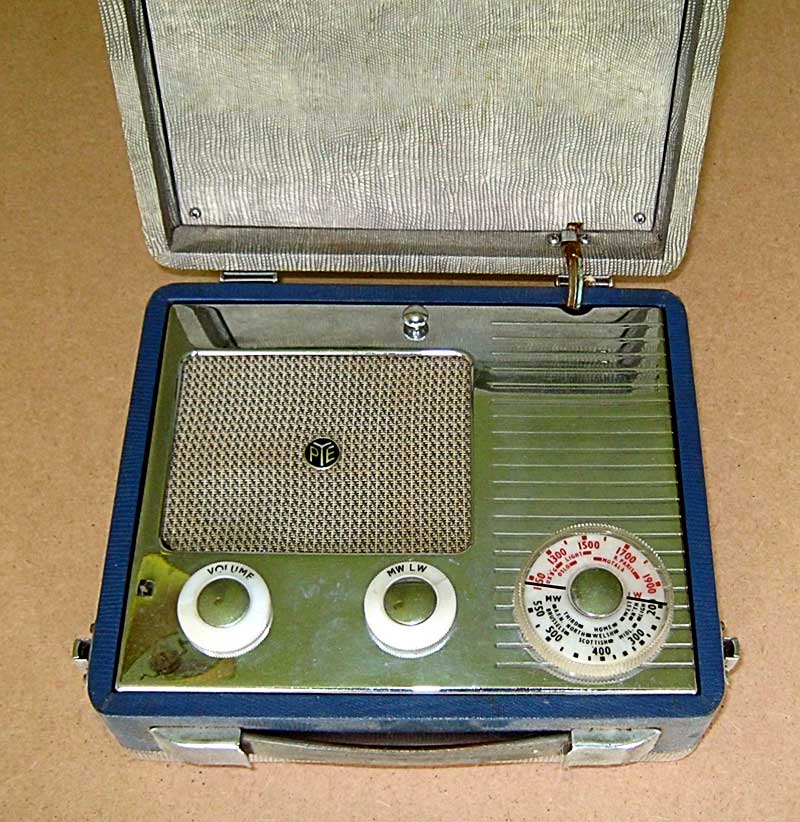 We also had a PYE portable radio (see photo on
left)
that operated on both Long and Medium wavebands. This worked from a
1.5V Low Tension (LT) battery that operated the valve heaters and an
expensive 90V High Tension (HT) battery equivalent to about £10 at 2012
prices. The compact aerial was a coil of wire than ran round the edges of the lid. A
micro switch turned on the radio when the lid was lifted. Little use now as you can't get the
HT batteries which in any event did not
last long. Note that museums can demonstrate such radios working using a
bank of ten PP3 batteries.
We also had a PYE portable radio (see photo on
left)
that operated on both Long and Medium wavebands. This worked from a
1.5V Low Tension (LT) battery that operated the valve heaters and an
expensive 90V High Tension (HT) battery equivalent to about £10 at 2012
prices. The compact aerial was a coil of wire than ran round the edges of the lid. A
micro switch turned on the radio when the lid was lifted. Little use now as you can't get the
HT batteries which in any event did not
last long. Note that museums can demonstrate such radios working using a
bank of ten PP3 batteries.
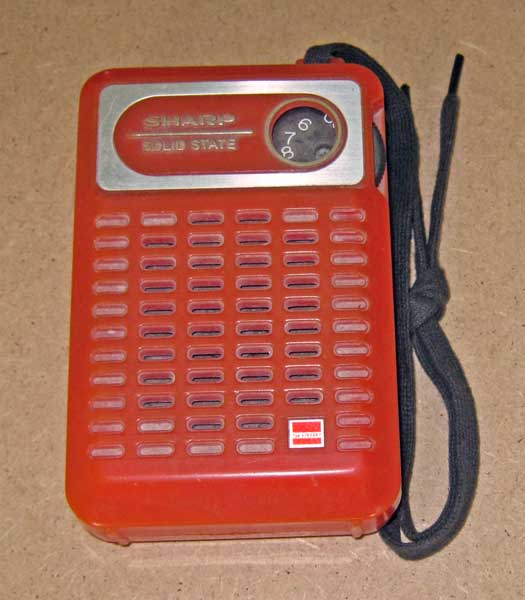 In the 1970s
sales of UK made radios declined as radios began to be imported from Japan
and small medium waveband transistor radios were popular that you could put
in your pocket and use with an earpiece. See example of Sharp pocket radio
on the right which operated from two AA batteries.
In the 1970s
sales of UK made radios declined as radios began to be imported from Japan
and small medium waveband transistor radios were popular that you could put
in your pocket and use with an earpiece. See example of Sharp pocket radio
on the right which operated from two AA batteries.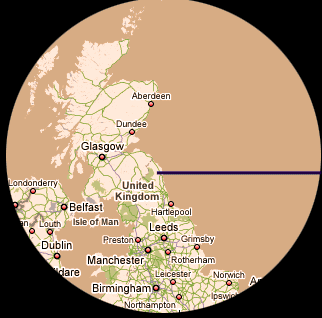 Decca Radar which sold marine radars was a division of the British
Decca Company that also sold records and record players. It was acquired by
Racal in 1980.
Decca Radar which sold marine radars was a division of the British
Decca Company that also sold records and record players. It was acquired by
Racal in 1980.